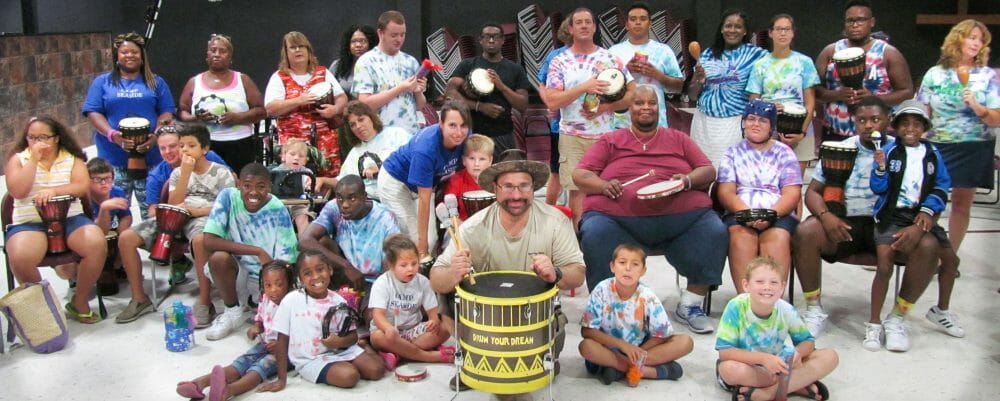The Autism NoteBook – April/May 2014 :
Awareness of the Rhythm… Natural Groove Circle Style
By Jorge Ochoa
Many children with autism seem to have an innate natural rhythm. Does your child tap, flap, or beat on whatever is in his field of reach? Do his beats shift with his moods? Is he comforted by simple patterns in his environment? If the answer is “yes”, then maybe it’s time to consider participating in a drum circle.
What’s it all about?
“A drum circle is a rhythm-based event that utilizes a variety of hand drums and percussion instruments to empower a community of participants with the ability to create beautiful, spontaneous music. Drumming and cooperatively creating rhythmic based music as part of a group is a kinesthetic activity that involves everyone, regardless of musical experience or ability. A drum circle benefits individuals by connecting them to a common purpose of creative self-expression … groups have found the power that drum circles have to create an environment for joy, expression, team building, stress relief and communication.” – Drum Circle Facilitators Guild.
Just Play
“The act of playing is an important tool that influences a child’s life. The primary goals of childhood are to grow, learn, and play. It is often through play that children learn to make sense of the world around them. It is a child’s ‘job’ or occupation to play to develop physical coordination , emotional maturity, social skills to interact with other children, and self-confidence to try new experiences and explore new environments.” (AOTA, 2012) Far too often in the present world of ever-exhausting deadlines, we have a tendency to forget to take a moment and “just play.”
Activities like a drum circle encourage play, as well as other functional life skills. Here kids aren’t asked to “perform” what someone else is dictating; rather children are invited to share their own personal rhythm. They learn a variety of ways to express themselves in a nonverbal, non- confrontational, and free-spirited way. This type of activity helps kids with autism move beyond their “boundaries” and gives them a “sense of belonging”.
How the Session Begins
In a drum circle, special attention is given to the set-up. Chairs are placed in a circle (which includes one for the instructor). By keeping the group fairly small, it is possible to give individualized and extended attention to the participants. Drums are placed on every other chair and alternated with other percussion instruments such as shakers and rhythms sticks. Additional chairs are placed around the outside of the circle for family and loved ones to sit and assist as needed. Each session begins with some basics on how to play the instruments and once a level of comfort is reached, the beat goes on.
A variety of skills, far surpassing musical ability, can be developed as a result of participating in a drum circle.
Communication
Being part of a drum circle gives both verbal and non-verbal children the chance to experience the give and take that occurs during a conversation. During call and response sessions, one beats the drum, and then the next one beats the drum, keeping in rhythm with one another. In addition, drumming can give children a voice and a means to express their emotion through the rhythm, tone, and volume of their drumming.
Focus and Attention
Since this activity has no intimidating qualities and the children are excited to participate, implementing “follow the leader” activities is simple. The instructor begins playing a simple rhythm and tells the group to start playing when they hear the word “go”. Next, the instructor plays and each person plays when their name is called. They continue playing and the group builds upon each other’s rhythm. This helps in building attention, self-control, and teamwork.
Turn-taking and Sharing Skills
Different instruments are played together at any given time during a drum session. The shakers may play first, then the sticks, and finally the drums. Each group has the opportunity of alternating their playing. Boy and girl playing are also alternated. These 2 activities enhance turn-taking skills. Half way through the session, sharing skills are targeted when those who have a drum switch with someone that has a shaker or rhythm sticks. Everyone gets the chance to experiment with different instruments.
Motor Skills
During drumming sessions, participants utilize eye/hand coordination, vestibular movement and visual perception. Motor skills emphasized include coordination, strength, and endurance as hands and arms are moving and the body is swaying to the rhythm.
Sensory Acceptance
Group drumming is surely a sensory “rich” experience. It assists with reinforcing body awareness, touch, balance, vision, and hearing skills. There have been reports of children becoming less sensitive to loud sounds after participating in drumming activities.
It brings a smile to everyone’s face when the facilitator of a drum circle senses the enthusiasm of the crowd and brings the playing to a universal halt with a “1, 2, 3, 4, stop! “. The children silence in unison. A that moment it’s easy to see the calmness, yet excited looks on their faces. They wait with anticipation for the cue to continue. As soon as they hear the anticipated “1…2 … back to the groove!” they are ready to join the group jam once again.
Jorge Ochoa is a registered and licensed occupational therapist living in San Antonio, Texas. He facilitates TamboFunction through his company Tambo-Rhythms. More info on group drumming can be found at www.tamborhythms.com

